Waste Statistics 2005
1 Waste generation and treatment
- 1.1 Waste generation 2005 and developments 2004-2005
- 1.2 Waste management in 2005
- 1.3 Treatment of waste without residues and construction and demolition waste
- 1.4 Treatment by source and waste type
- 1.5 Developments in waste generation 1994-2005
1.1 Waste generation 2005 and developments 2004-2005
Waste generation in 2005 and developments in waste arisings from 2004 to 2005 are presented in Table 1.
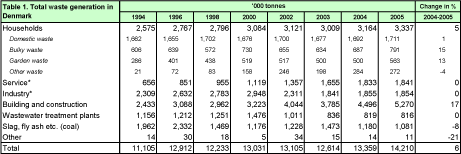
Source: ISAG; Danisco; the Association of Danish Recycling Industries and large scrap dealers; Elsam; Energi E2; and Reports to the Danish EPA on sludge from municipal wastewater treatment plants applied to farmland etc., and incineration of sludge at sludge incineration plants. (For sludge for recycling and incineration, figures from 2002 have been applied to 2005 - see footnote 26). Sludge is stated in wet weight, however from 2001 sludge for mineralisation which has been adjusted to 20 per cent dry matter. Sludge for long-term storage has been included in sludge amounts applied to farmland etc. Sludge for recovery has been included in sludge amounts for incineration.
The figures do not include imports of waste. Waste generation is stated as amounts of waste delivered to treatment plants from all primary sources. Primary sources include waste generators other than waste treatment plants (reprocessing plants, incineration plants, composting/biogas plants and landfills). Slag, fly ash and flue-gas cleaning products from waste incineration plants are therefore not included in the statement, as this would result in the waste being counted twice. Moreover, waste from the primary source recycling centres/transfer stations has been allocated among the other primary sources. The principles behind this allocation are explained in Annex 2.
Other waste includes the fractions packaging waste, plastic, sludge, and electrical and electronic equipment.
*The figures pertaining to service and industry from 2001 and onwards should be interpreted with some caution since there are fluctuations in the figures for the two sources which cannot be readily explained.
In 2005, Danish waste generation amounted to 14,210,000 tonnes. This corresponds to an increase of 6 per cent on the 2004 figure. Most of this increase stems from a 17 per cent increase in construction and demolition waste. Waste amounts of slag, fly ash, etc. have gone down 8 per cent.
Waste from households amounted to 3,337,000 tonnes in 2005. This is a 5 per cent increase in waste generation compared to 2004. The four types of waste from households either show no changes or have fluctuated slightly.
Domestic waste arisings remain almost unchanged from previous years. As Table 1 shows, domestic waste arisings have increased by a total of 3 per cent during the period 1994 - 2005, showing only very slight changes from year to year[3]. Domestic waste includes separately collected paper, glass, organic waste, and other waste.
The amount of bulky waste increased dramatically by 15 per cent, or 104,000 tonnes, compared to 2005. The increase in amounts of bulky waste can be ascribed e.g. to the fact that people have a greater disposable income and therefore home refurbishment etc. and procurement of new furniture etc. are more frequent.
The amount of waste reported as other waste fell by 4 per cent, which corresponds to 12,000 tonnes. Packaging waste is included under other waste. Separated packaging waste became subject to reporting to the ISAG for the first time in 2001. However, this waste type is still not being reported to a sufficient extent. Therefore, packaging waste reported to the ISAG does not give a real picture of the total amount of collected packaging waste.
Waste from the service sector amounted to 1,841,000 tonnes in 2005, which is a slight increase on 2004; in absolute figures an increase of 8,000 tonnes. Waste from the service sector includes waste from institutions, trade and offices.
Waste from industry is more or less the same as in 2004. In reality, however, there has been a drop of in the waste volume of 1,000 tonnes compared to 2004.
Since 2001 there has been a shift between sectors in that waste volumes from industry have been falling, while waste volumes from the service sector have been rising. Waste volumes from industry thus fell by 37 per cent in the period 2000 to 2005, whereas in the service sector volumes increased by 65 per cent. From 2004 to 2005 the amount of waste from industry and the service sector has remained unchanged. That waste volumes from these two sources changed significantly in the previous years may be due to faulty reporting as the source "manufacturing etc." was discontinued from 2001.
Structural changes, i.e. the fact that society is changing from an industrial to a knowledge society, may be another reason for the shift between the two sectors. The shift could be supported e.g. by the fact that from the early 1990s to 2003, the number of enterprises in traditional industry has gone down, while the number of new enterprises in the knowledge services industry has increased dramatically[4].
However, it is interesting how the shift between the two sectors seems to have evened out. This could be interpreted as reflective of a better registration practice, bearing in mind the structural changes mentioned above, and the fact that waste arisings might be settling at a natural level. Future statistics will tell if this is the case.
The generation of waste in the building and construction sector increased dramatically from 2004 to 2005. Volumes of construction and demolition waste amounted to 5,270,000 tonnes in 2005, which is 774,000 tonnes, or 17 per cent, more than in 2004. This increase is present in the following fractions: various non-combustible, concrete, asphalt, soil and stone, other recyclable waste, and other waste. These fractions rose by 22 per cent, 13 per cent, 3 per cent, 41 per cent, 18 per cent and 21 per cent, respectively. On the other hand, the fractions tile and other construction/demolition waste fell by 2 per cent and 11 per cent respectively. (See Table 30).
The explanation for the dramatic increase in the amount of soil and stone is increased activity in the building and construction sector. By far the major part, or 94 per cent, of waste generated by the building and construction sector is recycled. A total of 565,000 more tonnes of soil and stone were reported in 2005.
The amount of sludge from municipal wastewater treatment plants has remained more or less the same as in 2004. In 2005 the amount was 816,000[5] tonnes stated as 20 per cent dry-matter content. Therefore 3,000 tonnes less has been registered than in 2004.
Waste generation at coal-fired power plants fell by 8 per cent, from 1,180,000 tonnes in 2004 to 1,081,000 tonnes in 2005. This is primarily due to the fact that Denmark's actual consumption of coal for energy generation fell significantly from 2004 to 2005. In the period 1996 to 2000, there was a fall in waste arisings from coal-fired power plants. This can be attributed e.g. to the fact that there has been a conversion of energy generation from coal to renewable energy resources. In 2000 and 2005, Denmark had net imports of electricity[6].
1.2 Waste management in 2005
In the following, developments in Danish management of total waste arisings are described. Waste management is compared to treatment targets in the Danish government's Waste Strategy 2005-2008.
Table 2 shows that 9,545,000 tonnes, corresponding to 67 per cent of total waste arisings, were recycled in 2005. In absolute figures, this is an increase of 799,000 tonnes in recycled waste relative to 2004.

Source: same as Table 1, and the Danish government's Waste Strategy 2005-2008.
The total sum of the percentage distribution between the different treatment options for 2001, 2003, 2004 and 2005 does not add up to 100 per cent due to rounding.
Special treatment includes treatment of hazardous waste, including healthcare risk waste.
The amount of waste incinerated in 2005 came to 3,473,000 tonnes. This is inclusive of 339,000 tonnes of sludge from municipal wastewater treatment plants. This is actually a 36,000-tonne increase in waste amounts compared to the previous year, and it corresponds to 24 per cent of total waste arisings.
Waste led to landfill in 2005 amounted to 983,000 tonnes, which is a decrease of 41,000 tonnes from 2004. The rate of waste landfilled amounts to 7 per cent of total waste arisings. The percentage share of waste led to landfills fell by 62 per cent in the period 1994 to 2005, corresponding to a fall in landfilled waste amounting to 1,630,000 tonnes.
As the table shows, the relative distribution in recent years among treatment options has varied only little. Variations are often explained by developments in waste arisings in individual fractions. For example, variations in amounts of residues from coal-fired power plants and construction and demolition waste have large implications on the total rate of recycling, as these two waste types account for a large percentage of total waste arisings and typically have a rate of recycling of 90 per cent or more.
In the Danish government's Waste Strategy 2005-2008 the target of stabilising Danish waste generation is supplemented by a number of qualitative elements such as better exploitation of resources in waste, better quality in treatment of waste, and limitation of problems caused by environmental contaminants in waste.
Overall waste treatment targets for 2008 in the government's Waste Strategy 2005-2008 are 65 per cent recycling, 26 per cent incineration, and a maximum of 9 per cent landfilling.
As can be seen from Figure 1, the overall targets for treatment of waste in 2008 were met in 2005 and were already met for the first time in 2003. In 2004, one per cent of total waste arisings was reported under the treatment option storage. Storage means temporary landfilling of waste suitable for incineration until incineration capacity is available. This means that the waste is stored until it can be incinerated for the purpose of energy/heat generation.
The general fall in the rate of waste led to landfills can be attributed to the ban on landfilling of waste suitable for incineration that came into effect on 1 January 1997. However, there are other important factors as well.
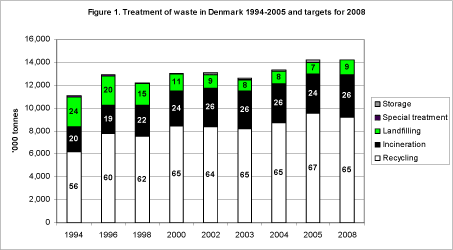
Source: same as Table 1. Note that total waste arisings in 2008 have been set to correspond to waste arisings in 2005. This should not be seen as a projection of developments in total waste arisings.
The amount of residues from coal-fired power plants was reduced significantly and recycled to a greater extent. Thus as opposed to previously, a larger proportion was recycled rather than landfilled.
1.3 Treatment of waste without residues and construction and demolition waste
Amounts of residues from coal-fired power plants not only depend on energy consumption in Denmark, but also on exports of electricity to Sweden and Norway. Furthermore the change from use of coal and coke as fuel to natural gas and renewable energy continues to take pace.
Since 1996, when Denmark's electricity exports to Sweden and Norway were particularly large, amounts of residues decreased steadily up until and including 2005. In fact, this is a 1,251,000-tonne decrease (see Table 32), corresponding to a 54 per cent reduction. In the period 2004 to 2005, there has been a fall of 99,000 tonnes, which is primarily attributable to falling exports of electricity to e.g. Sweden, Norway, and Germany. Thus, net exports fell by 148 per cent from 2004 to 2005.[7]
Naturally, this has an impact on developments of total waste arisings, but as residues have a very high rate of recycling, it also has an impact on the ability to meet overall treatment targets.
A similar picture is seen for construction and demolition waste. As discussed in section 5.4, the rate of recycling of construction and demolition waste typically reaches around 90 per cent.
It is therefore interesting to look at the distribution of waste between the different treatment options, if residues and construction and demolition waste are excluded from the statistics.
Figure 2 shows the distribution between the different treatment options when residues from coal-fired power plants are excluded from the statistics.
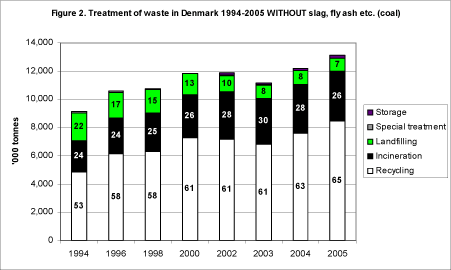
Source: same as Table 1.
When residues are excluded it is seen that 65 per cent of remaining waste was recycled in 2005, which is an increase of 880,000 tonnes compared to total amounts in 2004. This more or less means that a substantial part of the increase in overall waste arisings is to be found in construction and demolition waste volumes, of which, as mentioned, a large part is being recycled.
The rate of remaining waste in 2005 which was incinerated is 26 per cent, which is to say that 36,000 tonnes more waste were incinerated in 2005 than in the year before. The proportion of waste led to landfills was 7 per cent. In absolute figures this means that 23,000 tonnes less waste was landfilled in 2005 than in 2004.
In absolute figures this means that in 2005, apart from residues, 13,129,000 tonnes of waste were generated, corresponding to an increase of 8 per cent on 2004. Of this, 8,492,000 tonnes were recycled, whereas 3,473,000 tonnes were incinerated, and 955,000 tonnes were landfilled. Moreover, 18,000 tonnes were given special treatment and 191,000 tonnes have been temporarily landfilled until incineration capacity becomes available[8].
Total waste amounts without waste from coal-fired power plants increased by 44 per cent from 1994 to 2005.
Waste from the building and construction sector has also been excluded from statistics in Figure 3. As is evident, this will make the recycling rate fall and the rate of waste which is incinerated or landfilled grow.
In absolute figures, waste generation without residues and without waste from building and construction amounted to 7,859,000 tonnes in 2005, which is 175,000 tonnes, or about 2 per cent, more than in 2004. In other words, there has been a slight increase in total waste arisings, if residues and waste from building and construction are excluded. This increase is explained by an overall increase of waste from households of 173,000 tonnes from 2004 to 2005. (See Table 1).
Residues from coal-fired power plants and construction and demolition waste are recycled to a very large extent: in 2005, 97 per cent and 94 per cent respectively, cf. Chapter 5. As can be seen from Figure 3, the high recycling rates for these two sources contribute significantly to the overall recycling rate for the remaining waste. Since, proportionally, construction and demolition waste constitutes a large part of overall waste arisings, it means that the recycling rate falls when this waste type is excluded from the statement.
The recycling of residues from coal-fired power plants and construction and demolition waste will therefore also have a great influence on fulfilling the treatment targets set out in the government's Waste Strategy 2005-2008.
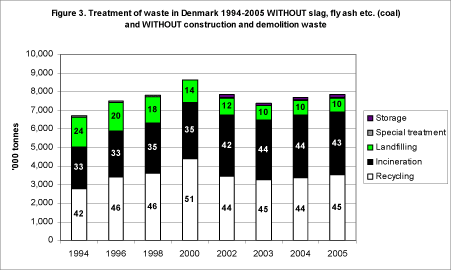
Source: same as Table 1.
1.4 Treatment by source and waste type
Figure 4 shows total waste generation in 2005 analysed by source and treatment option. Figure 5 shows waste generation analysed by waste type and treatment option. Tables with detailed figures are given in Annex 1.
Figure 4 shows that especially waste from the building and construction sector, power plants, industry and wastewater treatment plants is characterised by very high recycling rates. Consequently, the targets for recycling set out in Waste Strategy 2005-2008 have been met for waste generated by these four sectors (see Annex 1).
The high rate of recycling for industry is especially attributable to recycling of ferrous metal. Despite the fact that the amount of waste from industry led to landfill is falling, too much waste from this sector is still being landfilled with 19 per cent against a target of 15 per cent. A challenge lies ahead to divert larger amounts of the other fractions besides ferrous metal from landfilling to incineration or recycling.
The recycling rate for waste from the service sector has increased considerably. Thus, in 2005, 45 per cent of the waste from this sector was recycled, whereas, in 2004, only 36 per cent was recycled. The target for recycling of waste from the service sector is 50 per cent by 2008.
Too much waste is still being landfilled: 8 per cent against a target of 5 per cent. For the service sector the challenge is therefore to divert more waste from landfilling to recycling.
Treatment of the waste type domestic waste has almost reached the target for 2008. Thus, in 2005, 18 per cent of this waste type was recycled against a target of 20 per cent by 2008. In the period 1994 to 2005 the recycling rate fluctuated between 14 per cent and 18 per cent (see also Figure 7).
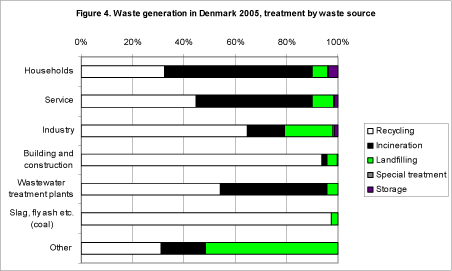
Source: same as Table 1.
The target is to reach a recycling rate for domestic waste of 20 per cent in 2008, whereas the targets for incineration and landfilling are 80 per cent and 0 per cent respectively. The rate of domestic waste incinerated in 2005 reached 81 per cent, whereas about 1 per cent was led to landfill[9].
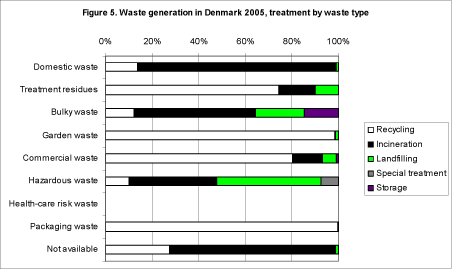
Source: same as Table 1.
1.5 Developments in waste generation 1994-2005
Table 3 shows total waste arisings in Denmark for the years 1994 to 2005. Breakdown of the information is by source.
There was a 28 per cent increase in total waste arisings in the period 1994 to 2005.
Waste generation was largest in 2005.
In the period 1994 to 2005, waste arisings have fluctuated, but have stayed at around 13 million tonnes in recent years, however with greater increases in 2004 and 2005. As in 2004, the great increase in waste arisings in 2005 is due to growing waste amounts from building and construction. Soil and stone is the waste type that has grown the most, due to a growing number of building and construction works. The total amount of construction and demolition waste increased by 775,000 tonnes from 2004 to 2005. Of this increase, soil and stone accounted for 565,000 tonnes.
The increase in waste arisings in the first half of the 1990s may be due partly to the fact that coverage of the ISAG system increased and partly due to real increases in waste arisings.
The large amounts of waste in 1996 were primarily due to particularly high amounts of residues from coal-fired power plants in 1996, which in turn were due to large exports of electricity to Sweden and Norway. However, increasing waste arisings in 2000 must be attributed to an increase in waste from households and waste from building and construction. The same applies for 2002. As mentioned, for 2004 and 2005, the increase in waste arisings must be ascribed to more waste from the building and construction sector.
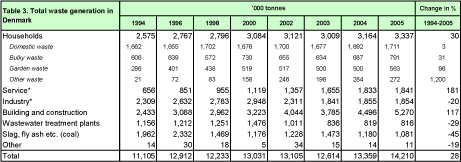
Source: same as Table 1.
Other waste includes the fractions packaging waste, plastic, sludge, and electrical and electronic equipment.
*The figures pertaining to service and industry from 2001 and onwards should be interpreted with some caution since there are fluctuations in the figures for the two sources which cannot be readily explained.
[3] Developments from 1994 to 2005 are described in more detail in section 1.5.
[4] Statistical Ten-Year Review 2006. Statistics Denmark.
[5] As of yet, there is no statement from the municipal wastewater treatment plants of the amounts of sludge applied to farmland or incinerated at sludge incineration plants in 2005. For recycling and incineration, the 2002 figures from the Danish EPA's sludge statistics have therefore been used, while for landfilling the 2005 figures from the ISAG have been used. See "Sewage sludge from municipal and private wastewater treatment plants in 2002". Environmental Review No. 5, 2004, Danish EPA.
[6] Preliminary figures from the Danish Energy Authority on energy generation and consumption, and CO2 emissions in 2004. Denmark's actual energy consumption of coal and coke was 184 PJ in 2004. In 2005, this figure has dropped to 156 PJ.
[7] The Danish Energy Authority's monthly electricity statistics.
[8] Exemption clause in Section 37(3), Danish Statutory Order on Waste (Statutory Order No. 619 of 27 June 2000).
[9] Note that domestic waste suitable for incineration must be assigned to incineration. However, for islands that are not connected by land to an incineration plant there is an exemption from this duty of assignment.
Version 1.0 September 2007, © Danish Environmental Protection Agency